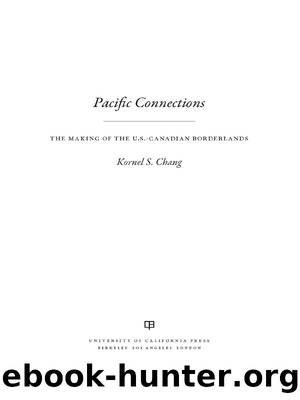Pacific Connections: The Making of the U.S.-Canadian Borderlands by Kornel S. Chang

Author:Kornel S. Chang
Language: eng
Format: epub
Publisher: University of California Press
CONVERGING ON REVOLUTIONARY MANHOOD
Within IWW circles, no figure was held in higher esteem than the South Asian revolutionary. Venerated for his militant radicalism that called for immediate revolution and aggressively confronting the ruling elite, the South Asian revolutionary was held up as a paragon of virile manhood. âThere may not be as much sedition among the Hindus of British Columbia as among Canadian-born Socialists who rant of the flag as âa bloody ragâ; but our Socialistic seditionists have never yet been accused of collecting two million dollars to send home to India to buy rifles for the revolution.â81 The emphasis on militancy, confrontation, and direct actionâthat is, the vision of a gendered insurgencyâbrought virile white and Asian radicals together in moments of interracial and interradical solidarity. As a spokesperson for the IWW boasted, âOur workersârevolutionists, you would call themâare at work among the Hindu in India.â82
The rendering of the South Asian as a heroic insurgent helped to distance him from and complicate his racial identification as an âAsiaticâ and facilitated an interracial alliance that brought South Asian revolutionaries in contact with white labor radicals and their aspirations and ideas, and vice versa. Leading revolutionaries Hussain Rahim and Taraknath Das cultivated close ties with intellectuals, unionists, and activists associated with the IWW and the Sociality Party in Canada and the United States. Das began publishing his anticolonial newspaper, the Free Hindusthan, with financial assistance from the Socialist Party in Canada (SPC), and when he needed to relocate to avoid government censors in 1908, the Western Clarion offered the use of its offices in Seattle. The editors of the socialist paper also furnished Taraknath Das with space in its newspaper to air his anticolonial views. In the case of Hussain Rahim, you will remember that it was his radical ties that so worried Dominion officials at the time of his entry and had them working so hard to keep him out of Canada. Confirming their worst fears, Rahim went on to engage in free speech fights, raise funds, translate organizing literature, and recruit members for the IWW and the SPC in British Columbia. His efforts earned him a seat on the SPCâs Executive Committee, which made him the first nonwhite person to be elected into the partyâs leadership.83 In this capacity, Rahim was believed to be the key figure in the spread of subversive ideas among the South Asian immigrant population: âThe Hindus have up to the present never identified themselves with any particular political party and the introduction by Rahim of the socialist propaganda into this community is, I consider a very serious matter, as the majority of these people are uneducated and ignorant and easily led like sheep by a man like Rahim.â84
Indeed, Rahim and other revolutionary leaders served as a bridge between white labor radicals and South Asian migrant workers. In 1913, Agnes Laut, reporting for the Saturday Night, wrote that she saw âlong lists of subscriptions from Hindu workmen to the IWW strike fundsâ during her investigations into Wobbly activities in British Columbia.
Download
This site does not store any files on its server. We only index and link to content provided by other sites. Please contact the content providers to delete copyright contents if any and email us, we'll remove relevant links or contents immediately.
| Africa | Americas |
| Arctic & Antarctica | Asia |
| Australia & Oceania | Europe |
| Middle East | Russia |
| United States | World |
| Ancient Civilizations | Military |
| Historical Study & Educational Resources |
The Bomber Mafia by Malcolm Gladwell(1179)
Submerged Prehistory by Benjamin Jonathan; & Clive Bonsall & Catriona Pickard & Anders Fischer(1161)
Facing the Mountain by Daniel James Brown(1130)
The Dawn of Everything by David Graeber & David Wengrow(1102)
The Way of Fire and Ice: The Living Tradition of Norse Paganism by Ryan Smith(1030)
Wandering in Strange Lands by Morgan Jerkins(1014)
Tip Top by Bill James(1001)
Driving While Brown: Sheriff Joe Arpaio Versus the Latino Resistance by Terry Greene Sterling & Jude Joffe-Block(1000)
Evil Geniuses: The Unmaking of America: A Recent History by Kurt Andersen(998)
Red Roulette : An Insider's Story of Wealth, Power, Corruption, and Vengeance in Today's China (9781982156176) by Shum Desmond(996)
F*cking History by The Captain(966)
It Was All a Lie by Stuart Stevens;(939)
White House Inc. by Dan Alexander(904)
Evil Geniuses by Kurt Andersen(900)
Treasure Islands: Tax Havens and the Men who Stole the World by Nicholas Shaxson(879)
American Dreams by Unknown(857)
American Kompromat by Craig Unger(847)
The Fifteen Biggest Lies about the Economy: And Everything Else the Right Doesn't Want You to Know about Taxes, Jobs, and Corporate America by Joshua Holland(814)
The First Conspiracy by Brad Meltzer & Josh Mensch(811)
